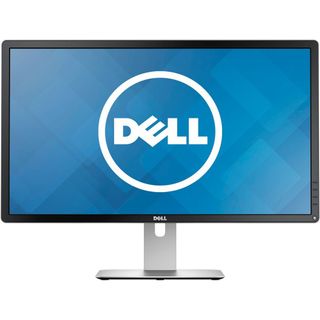Samsung U28D590D 28-Inch Ultra HD Monitor Review
Why you can trust Tom's Hardware
Results: Brightness And Contrast
To read about our monitor tests in-depth, please check out Display Testing Explained: How We Test Monitors and TVs. Brightness and Contrast testing is covered on page two.
Uncalibrated – Maximum Backlight Level
In addition to our review subject, the test group consists of four 28-inch TN panels: Asus’ PB287Q, Dell’s P2815Q, Planar’s IX2850 and Philips’ 288P6LJEB. To bring us up to six screens, we’re adding the excellent NEC EA244UHD 24-inch IPS display.

Samsung uses the same Innolux panel part as the other TN monitors, but manages to coax a little more light output from the U28D590D. There is a caveat, however. Out of the box, the HDMI Black Level is set to Low, which extends the dynamic range a little and clips the brightest details. When you change it to Normal, as we suggest, the max output drops to 339.2941cd/m2. It’s still plenty bright enough for any use we can think of.

The maximum black level lags just a bit behind the pack. It's not objectionable, though. Blacks are still reasonably deep with good detail.
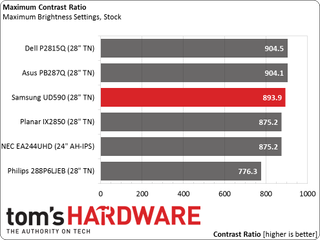
None of the screens top 1000:1. But the U28D590D only misses the top spot by a hair. If you line them all up, only the Philips would appear to lack a little image depth. The rest would appear the same.
Uncalibrated – Minimum Backlight Level
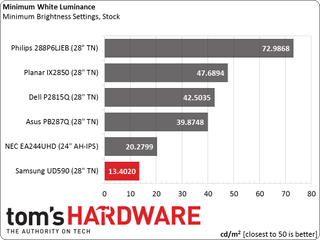
A minimum white level this low doesn’t have much practical application, since the image is so dim. Turning the brightness up to 8 results in 50cd/m2 of output.
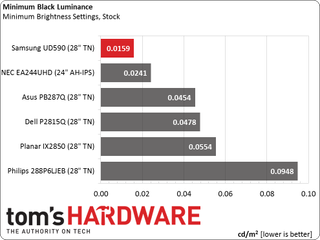
Of course, the black level is extremely low at this backlight setting. If you can work with such a dark image, you’ll enjoy very deep blacks.

Minimum contrast is fairly consistent with a drop of only five percent. The top three displays simply do a little better. We’re pleased to see that the U28D590D’s stock contrast performance is right there with the competition.
After Calibration to 200cd/m2
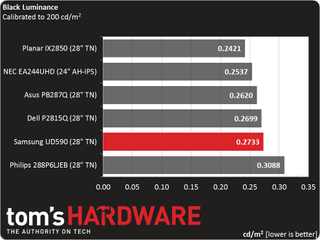
The calibrated black levels of all the screens in our group land close together. Even the Philips wouldn’t really stand out in a side-by-side comparison.
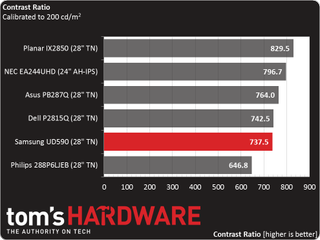
It’s common to give up some contrast when calibrating any monitor. We lost a little more with the U28D590D due to its HDMI Black Level setting. To avoid clipping and get the gamma tracking in line, we had to set it to Normal. The hit isn’t huge, but it does drop Samsung in the rankings.
ANSI Contrast Ratio

The Samsung’s ANSI contrast is solidly higher than its on/off figure. That’s rare in our experience, demonstrating good quality control. Remember that all of the TN-based panels here employ the same Innolux part. It’s up to each manufacturer to spend time testing every monitor before boxing and shipping. Samsung isn’t charging a lot for the U28D590D, but it is ensuring good performance from the factory.
Current page: Results: Brightness And Contrast
Prev Page OSD Setup And Calibration Of The Samsung U28D590D Next Page Results: Grayscale Tracking And Gamma ResponseStay on the Cutting Edge
Join the experts who read Tom's Hardware for the inside track on enthusiast PC tech news — and have for over 25 years. We'll send breaking news and in-depth reviews of CPUs, GPUs, AI, maker hardware and more straight to your inbox.

Christian Eberle is a Contributing Editor for Tom's Hardware US. He's a veteran reviewer of A/V equipment, specializing in monitors. Christian began his obsession with tech when he built his first PC in 1991, a 286 running DOS 3.0 at a blazing 12MHz. In 2006, he undertook training from the Imaging Science Foundation in video calibration and testing and thus started a passion for precise imaging that persists to this day. He is also a professional musician with a degree from the New England Conservatory as a classical bassoonist which he used to good effect as a performer with the West Point Army Band from 1987 to 2013. He enjoys watching movies and listening to high-end audio in his custom-built home theater and can be seen riding trails near his home on a race-ready ICE VTX recumbent trike. Christian enjoys the endless summer in Florida where he lives with his wife and Chihuahua and plays with orchestras around the state.
-
mgilbert Correction - I wound up with R=49, G=33, B=48. And this monitor is blindingly bright. I have brightness set at 40, contrast at 60, and sharpness at 52.Reply -
Charly2nd "If you want a 32-inch jumbo screen to anchor your high-end rig, you’ll still pay between $1500 and $2000."Reply
This is not true anymore. Benq and Acer bith sell 32inch IPS panels for under U$D1000. Also, Dell' has a 27 inch 4K IPS panel that sells for 700 dollars, but can be found regularly for U$D 500 during promotions. So, there are cheaper IPS options out there (I purchased one for U$D 524 - hasn't arrived yet), almost for the same price of these TN panels. -
airborn824 I have this monitor and i enjoy it, i got it for free. I Would buy the ASUS if it was my own money. Does anyone know if this is also getting Freesync support? I have 2x R9 290Reply -
Charly2nd My correction aside, I like the thoroughness of Christian's reviews. I come often to this site because of hardware reviews like these! Thanks!Reply -
Grognak Eh, TN on such a massive, 4K monitor is kinda counterintuituve. It's true that they're getting better when it comes to both viewing angles and colors, but that's still not quite IPS quality here. Also, the 98ms input lag is insane, most TVs don't go that high. I guess you can't be too demanding at that price.Reply -
Ilander The Amazon link to the PB287Q links to the incorrect product, mistakenly leading me to believe that it was 399.99 USD. That's a huge difference in price which really sets a person's opinion on value...please fix.Reply -
xj97 I had this monitor at work and ended up pawning it off on someone else. The panel was pretty decent, but it did NOT play well with sleep states over displayport. The monitor wouldn't wake up... I'd have to pull the power plug to reset the darn thing.Reply
Other than that I loved it, but the sleep issue was just too annoying. -
ceberle Reply15156989 said:I have this monitor, and am wondering why you tested it on HDMI, which only yields a 30 Hz refresh rate. Would using the DisplayPort input change any of the numbers significantly, especially considering that there is no option to change the black level when on DP? Would using DP affect input lag?
Also, I found the green level much too high out of the box, and my old HueyPro calibrator agreed. I wound up with R=49 G=43 B=48. And, using a couple of gamma test images, I found gamma to be way off. I used the QuickGamma utility to correct it. With these corrections, I have excellent image quality.
When I test monitors with the Accupel signal generator it is indeed over HDMI but since the input resolution is 1920x1080, the tests are run at 60Hz. I have made comparisons of HDMI and DisplayPort with regards to response and input lag and found no difference in speed. Resolution also makes no difference since the panel scales any incoming signal to its native resolution.
-Christian-
-
qlum Looking at these screens I think my upgrade to 4k for my primary monitor is going to wait a while longer. Especially since my 4 screen setup would require a vesa mount.Reply

